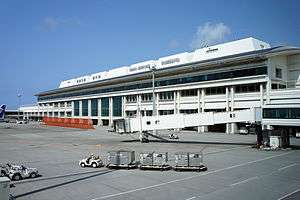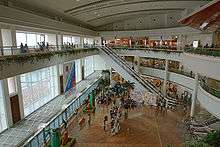Naha Airport
| Naha Airport 那覇空港 Naha Kūkō | |||||||||||
|---|---|---|---|---|---|---|---|---|---|---|---|
 | |||||||||||
| Summary | |||||||||||
| Airport type | Public | ||||||||||
| Operator | Ministry of Land, Infrastructure and Transport | ||||||||||
| Serves | Naha, Okinawa, Japan | ||||||||||
| Hub for | |||||||||||
| Focus city for | |||||||||||
| Elevation AMSL | 11 ft / 3 m | ||||||||||
| Coordinates | 26°11′45″N 127°38′45″E / 26.19583°N 127.64583°ECoordinates: 26°11′45″N 127°38′45″E / 26.19583°N 127.64583°E | ||||||||||
| Website | http://www.naha-airport.co.jp/en/ | ||||||||||
| Map | |||||||||||
 OKA Location in Japan | |||||||||||
| Runways | |||||||||||
| |||||||||||
| Statistics (2015) | |||||||||||
| |||||||||||
|
Source: Japanese Ministry of Land, Infrastructure, Transport and Tourism[1] | |||||||||||
Naha Airport (那覇空港 Naha Kūkō) (IATA: OKA, ICAO: ROAH) is a second class airport located 4 km (2.5 mi) west of the city hall[2] in Naha, Okinawa. It is Japan's seventh busiest airport and the primary air terminal for passengers and cargo traveling to and from Okinawa Prefecture, Japan, and handles scheduled international traffic to Taiwan, Hong Kong, South Korea, and mainland China. The airport is also home to Naha Air Base of the Japan Air Self-Defense Force.
Naha Airport served 17.5 million passengers in 2014, an increase of roughly 3 million passengers in two years.
History
Oroku Aerodrome (小禄飛行場), an Imperial Japanese Navy airfield, opened in 1933. The base was taken over by the United States in 1945 and was renamed Naha Airport (那覇飛行場). Pan American World Airways and Northwest Orient began service to Naha in 1947.
The airport was closed for refurbishment between 1952 and 1954. Japan Airlines began service to Okinawa during this time and initially used Kadena Air Base.
Air America operated interisland flights to Miyako and Ishigaki from 1964 to 1967, when Southwest Airlines (now Japan Transocean Air) took over these routes.
Okinawa was returned to Japan in 1972. In 1982, Naha Airport was transferred from US military control to the Japan Air Self-Defense Force.
The airport was a popular connecting point between Taipei and Shanghai prior to the opening of direct flights between mainland China and Taiwan.
The basic and detailed design engineering works in addition to the later construction management phase of the main passenger terminal were awarded in the 1990s in part to the Japan Branch of the American design-build engineering company, The Austin Company, which joined Japanese firms in a joint venture design consortium.
Peach, a low cost carrier based at Kansai International Airport in Osaka, announced that it would establish its second hub at Naha in July 2014, which would initially have flights to Osaka, Fukuoka, Ishigaki and Taipei.[3] ANA Holdings, the parent company of both Peach and Vanilla Air, opened a new LCC terminal in a refurbished portion of the airport's cargo area in October 2012, and plans to open new international facilities in October 2014.[4]
Development
The airport has been undergoing major development projects that will continue to transform the airport:
- In 2008, the government agreed to significantly expand the domestic terminal, which will require the relocation of cargo facilities and the international terminal.
- The construction of a second 2,700m parallel runway began on March 1, 2014 (expected completion in 2020), on 160 hectares of reclaimed land.[5]
- The new international terminal opened in February 2014. The int'l terminal is again being expanded and will grow by 3000m2 in Nov 2016. A new building connecting the domestic and int'l terminals is due to be completed in 2020 along with the 2nd runway.[6]
- A LCCT terminal has been in operation since 2012.
- In addition, a 6 lane under bay tunnel for auto transport linking the airport with the Naha Port boosting the utility of the intermodal facility was completed in 2011. This tunnel will also link a 2.6 hectare Free Trade Zone near the Airport with another 122 hectare FTZ located at Nakagusuku Bay.
Terminals

- Domestic Terminal (1999) - replaced former domestic terminal, extended to include LCCT, other extensions works to conclude in 2016.
- LCCT Terminal (2012) - north annex of domestic terminal (Peach Domestic & International and Vanilla Air only).
- New International Terminal (2014) - replaced old international terminal
- Cargo Terminal (2009) - Former domestic terminal became the cargo terminal
Airlines and destinations
Passenger
Cargo service
All Nippon Airways operates an overnight cargo hub at Naha Airport, which receives inbound Boeing 767 freighter flights from key destinations in Japan, China and Southeast Asia between 1 and 4 a.m., followed by return flights between 4 and 6 a.m., allowing overnight service between these regional hubs as well as onward connections to other ANA and partner carrier flights.[14]
The hub began operations in 2009; by 2013 it served eight cities, and ANA had chartered a Nippon Cargo Airlines Boeing 747 freighter to handle demand on the trunk route from Narita International Airport.[15]
Accidents and incidents
- On December 11, 1994, Ramzi Yousef planted a bomb on Philippine Airlines Flight 434, which exploded while the flight was en route from Cebu to Tokyo, killing one passenger and injuring ten other passengers. The plane made an emergency landing at Naha Airport safely.
- On January 31, 2001, Japan Airlines Flight 907, bound for Naha from Tokyo International Airport, nearly collided with another Japan Airlines aircraft. The Boeing 747 for Flight 907 suddenly dived and avoided a DC-10.
- On August 20, 2007, China Airlines Flight 120, a Boeing 737-800, was taxiing to the ramp after landing when suddenly a fire started beneath the right wing, quickly engulfing the entire plane. All passengers and crew members were evacuated safely. Investigations later revealed that part of the slat drive mechanism pierced the fuel tank, and the leaking fuel ignited when it came into contact with hot engine parts.
- On June 3, 2015, an All Nippon Airways Boeing 737 bound for Sapporo aborted takeoff at Naha after a JASDF CH-47 Chinook helicopter crossed its departure path without clearance. An inbound Japan Transocean Air flight landed on the same runway, stopping 400 meters behind the ANA aircraft, despite an air traffic control order to go around, which the JTA pilot claimed to have received after landing.[16]
Access
The airport is served by the Okinawa Monorail which carries passengers from Naha Airport Station to the center of Naha, and to the terminal at Shuri Station near Shuri Castle. Bus service is also available to many parts of Okinawa Island.
References
- ↑ "Naha Airport" (PDF). Japanese Ministry of Land, Infrastructure, Transport and Tourism. Archived from the original (PDF) on 21 October 2016. Retrieved 7 January 2017.
- ↑ AIS Japan Archived 2016-05-17 at the Portuguese Web Archive
- ↑ Yoshikawa, Tadayuki (21 January 2014). "ピーチ、那覇-福岡線開設 7月に第2ハブ稼働". Aviation Wire. Retrieved 22 January 2014.
- ↑ "ANA、那覇の国際線LCCターミナル公開 10日からピーチ使用". Aviation Wire. 8 February 2014. Retrieved 10 February 2014.
- ↑ http://flyteam.jp/news/article/19108
- ↑ http://english.ryukyushimpo.jp/2015/04/30/18285/
- ↑ "Air Seoul plans Okianwa launch in Sep 2018". routesonline. Retrieved 2 August 2018.
- ↑ "Beijing Capital Airlines to Start Hangzhou - Okinawa Service from late-Oct 2014". Airline Route. 22 October 2014. Retrieved 22 October 2014.
- ↑ "Juneyao Airlines Adds Nanjing – Okinawa Service from July 2016". airlineroute. Retrieved 11 April 2016.
- ↑ "Peach plans Okinawa – Kaohsiung launch in late-April 2018". routesonline. Retrieved 26 January 2018.
- ↑ "tigerair Taiwan adds Kaohsiung – Okinawa route in Mar 2017". routesonline. Retrieved 9 November 2016.
- ↑ "Vanilla Air Adds Okinawa - Taipei Route from Sep 2016". routesonline. Retrieved 25 May 2016.
- ↑ "Vanilla Air adds Ishigaki service in S18". routesonline. Retrieved 15 March 2018.
- ↑ "Archived copy" (PDF). Archived from the original (PDF) on 2013-08-21. Retrieved 2013-07-17.
- ↑ "全日空「沖縄貨物ハブ」上昇気流 国内外で路線拡充". 日本経済新聞. 24 August 2013. Retrieved 26 August 2013.
- ↑ "ANA jet aborts take-off after SDF copter cuts across its path at Naha airport". Japan Today. 4 June 2015. Retrieved 5 June 2015.
External links
| Wikimedia Commons has media related to Naha Airport. |
- Airport website (in Japanese)
- Airports of Okinawa
- Naha Airport Guide from Japan Airlines
- Airport information for OKA
- Charts for OKA / ROAH
- Current weather for ROAH at NOAA/NWS
- Accident history for OKA at Aviation Safety Network
